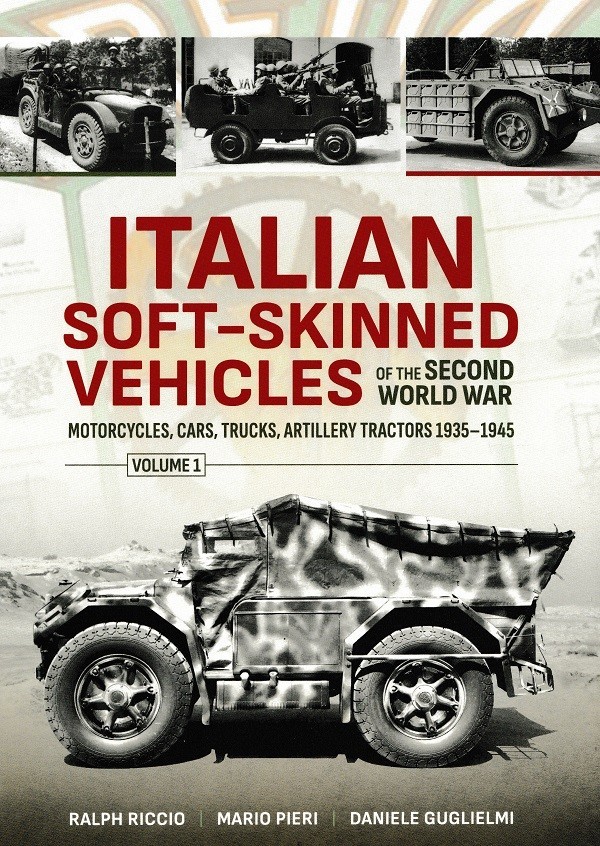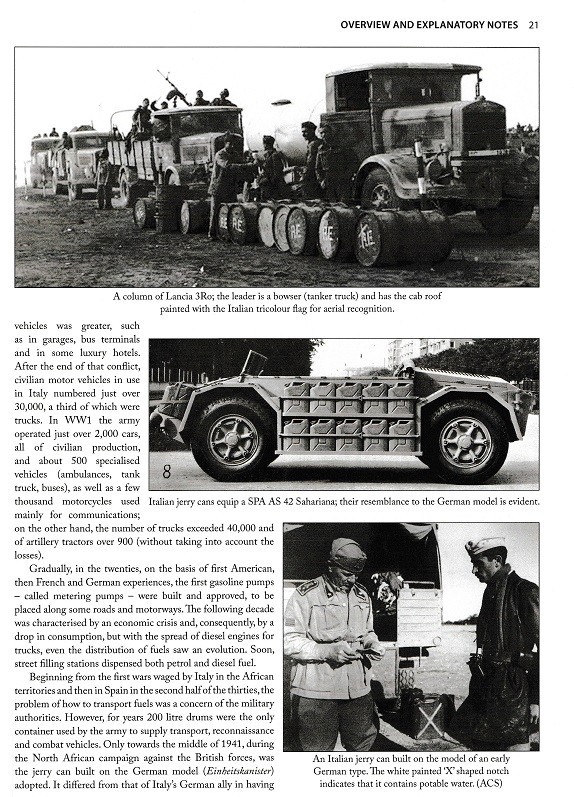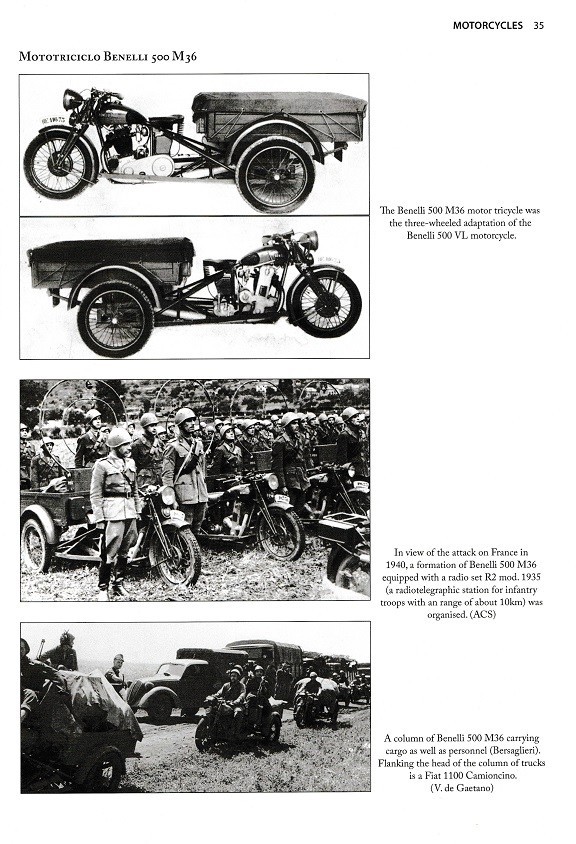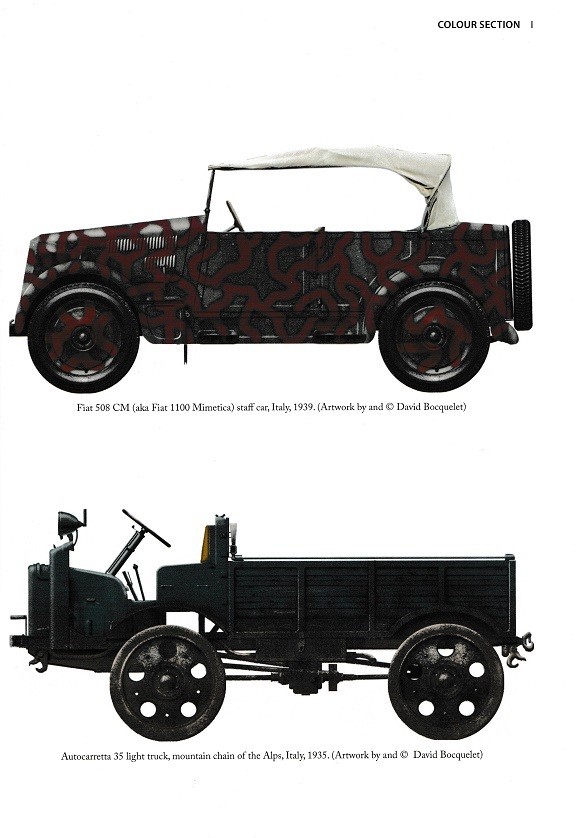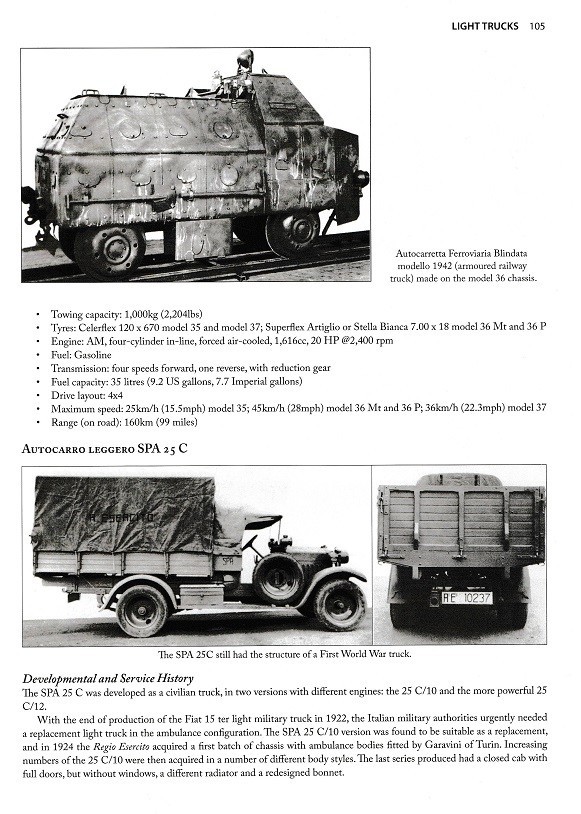HISTORY:
** The importance of land transport vehicles within an armed force is often underestimated by the average reader, attracted by more ‘martial’ subjects such as tanks and artillery. Nevertheless, it was thanks to motorcycles, cars, trucks and tractors that – since the early years of the twentieth century – men, weapons, ammunition, provisions, fuel, equipment and orders were transported, all elements without which AFVs, guns and infantry are unable to fight.
This first volume opens with a historical and technical introduction to the civil and military motorization in Italy from the 1920s to the end of the Second World War. This is followed by chapters dedicated to motorcycles, cars and light trucks. Each subject is described through its history, technical evolution and specifications, all supported by numerous contemporary photographs.
It is common opinion that the Italian Army was beaten above all because of the poor quality of its combat vehicles. Actually, impartial and in-depth studies, made since the end of the war, have revealed that the main problem was the shortage of vehicles, as well as an entirely insufficient logistics chain. The tank crews were able to compensate with bravery and experience for the fact that their tanks were, from a certain point on, inferior to those of their enemies, but the inadequate number of AFVs and other material was impossible to remedy. The same problem plagued the entire sector of military soft-skinned vehicles, a sign of Italy’s limited industrial capacity (and of procurement of raw materials and components) compared, for example, to its ally Germany. There were too few factories, too few skilled workers, and poor management skills within the armed forces.
However, if quantity was lacking, the same cannot be said for quality. Many models of efficient, robust and resistant vehicles were produced, especially in the sector of the so-called ‘standardized’ motor vehicles, such as those mentioned above and others that we will see. These vehicles allowed the Italian troops to move and fight in the large and difficult territories of North Africa, the Balkans and the Soviet Union and which brought home what was left of the defeated soldiers.
This is the first English-language study describing the soft-skinned vehicles of the Italian Armed Forces, starting from the 1930s, when Mussolini’s Italy faced some colonial conflicts and participated - albeit unofficially - in the Spanish Civil War, and throughout the Second World War. For each vehicle there is a file describing its evolution and the main technical aspects, accompanied by one or more photographs and, for the most significant examples, line drawings. The work is enriched by a historical introduction, various appendices and color profiles.**
** Quoted from the back cover of the book and the Helion & Company web site.
THE BOOK:
Helion and Company has released Italian Soft-Skinned Vehicles of the Second World War - Motorcycles, Cars, Trucks, Artillery Tractors 1935-1945 - Volume 1 as a 154-page soft cover book, 8.3 x 11.7 inches in size. Included with the text are black and white and color photographs, color illustrations, scale line-drawings, detailed captions and more. It has a 2023 copyright, a publication date of November 30, 2023, and the ISBN is 978-1-8045-1327-9.
THE CONTENTS:
- List of colour plates
- Acknowledgements
- Documentation sources
- Author’s Notes
- Abbreviations
- Glossary - Italian terms
- Foreword
- Prefixes and suffixes used in vehicle designations
- Introduction
1. Overview and Explanatory Notes
2. Motorcycles
3. Motor Cars
4. Light trucks
A biography will appear in Volume 2
THE TEXT:
Authors Daniele Guglielmi, Mario Pieri and Ralph Riccio provide a well written and informative text detailing Italian soft-skinned motorcycles, cars, trucks, and artillery tractors during the years of 1935 through 1945. The authors provide such details as to which vehicles were deemed suitable what type of terrain and environment, successes and failures, modifications and improvements made , theaters of conflict where they were used, which types and numbers of vehicles were supplied and in use by the German military, roles the vehicles were placed into such as troop carriers, staff cars, cargo haulers, radio/communications vehicles, etc. There is a wealth of information provided for all of the vehicles discussed and the detail specific minded individual will appreciate the specifics provided. The information provided for each type of vehicle includes engine and fuel types, wheels and tires, electrical systems, if they were right-hand drive, types of bodywork, developmental and service histories, technical descriptions, variants and specifications. The specification on the vehicles goes into great detail as to the designation of the vehicle, who produced it, the years produced, the numbers produced, vehicle length, width, height, unladen weight, wheelbase, front track, rear track, minimum turning radius, minimum ground clearance, carrying capacity, bed length, bed width, bed height, towing capacity, type of transmission, fuel capacity, speed and range. The text in the book is nicely written and well detailed. As I read through the text, I didn’t notice any spelling or grammatical errors. Grammar and spelling might not be an important factor to everyone however it is something that I take notice of and pass on my findings. The reader will not be disappointed with the text in this volume.
THE PHOTOGRAPHS:
A total of 311 black and white photographs and 7 color photographs are included in this volume. The photographs range from wide angle photographs to close-up detailed photographs. They contain a combination of in-action photographs, photographs removed from motion pictures to photographs that have been staged for the photographer. The photographs also include manufacturers official photographs as well as photographs from manufacturers and military manuals. Many of the photographs are from the manufacturer of the production vehicle prior to having any modifications, if any, done to them by the military. Several of the manufacturer’s photographs, and multiple view photographs, are of the same vehicle showing front, back, left and right profile views. I would say that the photographs that were chosen for this book are for the most part lesser-known photographs as opposed to photographs that are featured in other titles that deal with the same subject matter. The majority of the photographs are clear and easily viewable; however, a few have an out of focus look to them and some appear to be too dark, and others appear too light. This is typical for the discussed period of history and the quality of the photographs is no fault of the author and do not take anything away from the book. Authors Daniele Guglielmi, Mario Pieri and Ralph Riccio stuck to the title of the book and chose subject specific photographs and did not include photographs that strayed from the main subject of the book. The majority, if not all, of the photographs will prove to be a wealth of information to anyone interested in soft-skinned vehicles ranging from motorcycles to artillery tractors in use with the Italian military during the years of 1935 through 1945 due to the details they contain.
THE ILLUSTRATIONS:
There are 6 color illustrations included in the volume by illustrator David Bocquelet. The illustrations are very well done, nicely detailed and all of them are left-side profile illustrations of:
1. Fiat 508 CM (aka Fiat 1100 Mimetica) staff car, Italy, 1939
2. Autocarretta 35 light truck, mountain chain of the Alps, Italy 1935
3. Fiat 618 light truck, East Africa, 1936
4. SPA 38R light truck, Eastern Front, 1941
5. SPA CL 39 light truck, Eastern Front, 1941
6. SPA AS 37 (second series) light truck, North Africa, 1942
THE CAPTIONS:
The captions are well written and explain the accompanying photographs and illustrations nicely. Some of the captions are lengthy and provide a lot of detail while others are brief and just name the specific type of vehicle shown. The captions go into very specific detail as to the specific type of vehicle shown, the name of the manufacturer that produced the vehicle, years of manufacture, role of the vehicle, vehicle color, camouflage patterns and colors, specific parts shown on the vehicles such as tire types and specific tread patterns, weapon types, vehicle interior and exterior features, specific individuals names, dates, locations and other such pertinent information. As I read through the captions, I didn’t notice any spelling or grammatical errors.
LINE DRAWINGS:
There are 17 scale line-drawings included in this volume. Depending on the subject, they show front, back, overhead, left and right profile views. They are nicely done and will benefit the scale modeler and scratch-builder. The drawings are of:
1. Alce monoposto
2. Alce Motocarrozzetta
3. Fiat 508 CM
4. Fiat 508 CM with retractable canvas top
5. Fiat 500 A Topolino
6. Autocarretta 35
7. Autiocarretta 35
8. SPA 38 R
9. Fiat 618
10. 508 Camioncino three-speed, left-hand drive
11. Camioncino 508 III
12. CL 39 light truck with semi-pneumatic tyres
13. CL 39 light truck with semi-pneumatic tyres
14. CL 39 Coloniale
15. Autocarro Sahariano AS 37 first series
16. Autocarro Sahariano AS 37 first series
17. Autocarro Sahariano AS 37 second series
CONCLUSION:
I was impressed with this title from Helion & Company. This is a very nice reference book that contains a well written informative text, many subject specific photographs and illustrations, well detailed captions and more, all detailing Italian soft-skinned motorcycles, cars, trucks, and artillery tractors during the years of 1935 through 1945. I would have no hesitation in recommending this book to others as it will be a welcome addition to one’s personal reference library.
PRICE:
£20.00
This book was provided to me by Casemate Publishers as a representative of Helion & Company. Please mention that you saw the book reviewed here on the KitMaker Network when you make your purchase. Thank you.
